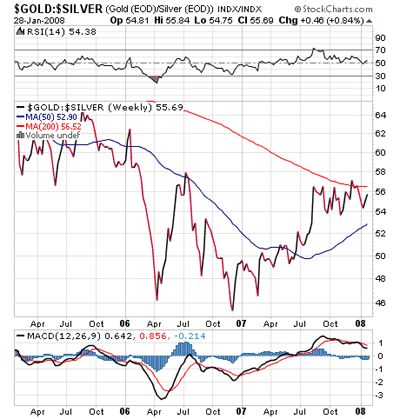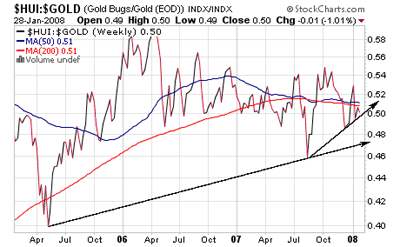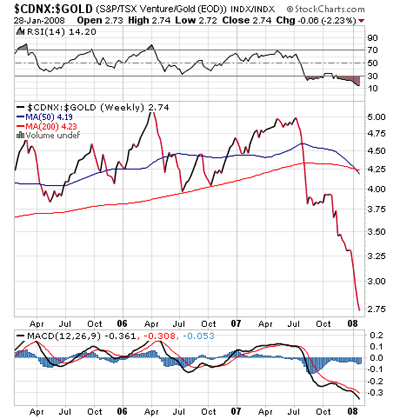| Taking Gold in the Inflation Olympics |
| By Bill Bonner |
Published
01/31/2008
|
Currency , Futures , Options , Stocks
|
Unrated
|
|
|
|
Taking Gold in the Inflation Olympics
We still don’t know which way this thing is going – the battle between greed and fear, that is. Stocks held steady yesterday. Oil too. The commodity index remains almost right on the 500 mark. Gold is sticking about $920.
And yesterday, the Fed lowered its key lending rate another 50 basis points to 3%. At that level, it is substantially below the nation’s inflation rate.
The official inflation rate was last clocked at a little over 4%. Then, the government helpfully takes out the things that matter most – food and fuel – and comes up with a “core” rate of inflation, which is much lower.
How much are consumer prices actually rising? Nobody really knows. Occasionally an economist or a newspaper will go out and buy things and then figure out how much they’ve gone up in price. Usually, they come up with “inflation” numbers closer to 10%. Naturally, results vary, depending on where you are and what you are buying.
If you measure “inflation” by looking at real money – gold – the current inflation rate is considerably higher. A year ago, an ounce of gold was still under $700. Today, it’s $920 – a jump of nearly 20%. (Colleague John Stepek thinks gold will go much higher...below.)
However you measure inflation, the opportunity to borrow at 3% has got to be a plus for people who want to borrow. In effect, the money is free.
But wait a minute; Mr. Market doesn’t usually give money away. What’s the catch?
The catch is that speculators have to do something with the money. And while consumer prices are rising, asset prices are falling. So, if you take the money, you have to find a place to invest it where your money will grow by at least 3%.
Stocks? Maybe not. Bonds – yields are so low...not much margin for error. Real property? Forget it. Borrowing capital in a declining economy rarely makes sense.
But for international speculators, abnormally low lending rates can be a gold mine. When Japan’s economy went into a slump, the government responded with low rates and high government spending – just as the U.S. government is responding now. This created an opportunity in the “carry trade,” where speculators were able to borrow yen at low interest rates and then trade the money for dollars to reinvest in U.S. stocks. American stocks rose 13 times from ’82 to ’07, while the yen mostly went down. In other words, the Japanese policies didn’t help warm up their own economy much, but they lit a fire under asset prices in much of the rest of the world.
That trade doesn’t work anymore, because the yen is rising and U.S. stocks are falling. But maybe the opposite trade would work – borrow dollars and invest in Japanese shares? The dollar will go down, thanks to the feds’ efforts to revive the U.S. economy, and Japanese shares are now nearly as cheap, relatively, as U.S. shares were in the early ’80s. We’re not proposing it, but stay tuned; maybe it will be our Trade of the Next Decade.
Another possibility, now, for speculators is the obvious one. One of the surest bull markets on the planet is in gold. The metal has been going up from $260 in the first year of George II’s reign, to over $900 in his last year. And as the dollar continues its decent toward its true value – and indeed the true value of all paper currencies – our Trade of this Decade is one thing that will always be worth having .
No one knows the future, but it doesn’t look like this bull market is going to stop very soon. Speculators can now borrow dollars at rates considerably below consumer price inflation, and then put them into gold, which is rising at 20% per year.
We only bring it up to highlight the tough spot in which our central bankers and politicians find themselves. They can make money cheaper and easier to get. They can pass a “stimulus” program at a cost of $146 billion. But what actually happens to the money? It ends up overseas. The feds can stimulate, but what they are really stimulating is Asian factories, the gold market, and global speculators – not the U.S. economy. Problems in the United States are too deep to be cured by a little more spending money. Besides, as we keep saying, the real problem in America is that people have borrowed and spent too much. Offering them more credit is not a solution; it’s a temptation, like wearing a short skirt while counseling a sex addict or turning your back on a kleptomaniac and then wondering what is missing.
Now, turning to the rebate package just passed by the House of Representatives, we haven’t looked at the details, just the amount. At $146 billion it is almost exactly the same amount as Frederic Mishkin figures the U.S. economy lost last year in consumer spending because of the bear market in housing. Fed governor Mishkin says that families cut back spending by seven cents for every dollar their houses go down in price (with a lag, we presume). Last year, that comes out to about $150 billion of reduced spending. Assuming consumers spend their rebate checks, the economy comes out even.
But the drop in consumer spending caused by housing is just a small part of the deflation hitting the U.S. economy. Stocks are down 15% from their peak, and finance and housing industry leaders are reporting huge losses that could reach into the trillions before it is over.
What’s more, the collapse in consumers’ purchasing power comes not just from a fall in their house prices, but also from the fact that they aren’t rising. At the peak of the bubble, homeowners were taking out as much as $250 billion per quarter in refinancing, home-equity lines, and other housing related credit. Now, that source is drying up.
The feds can try to replace that money, but they are not likely to succeed.
*** Colleague John Stepek, at MoneyWeek magazine, sees more gains for gold:
“I’m beginning to wonder if my target of a high in gold of $1150 an ounce this year was a little conservative...
“1. The gold-silver ratio will often close considerably, but it has been mired (or ‘consolidating’ as people on the wrong side of the trade like to call it), for ten months now between 57 and 54. Anything below 45 would be a warning sign – and we are a long way from that (see below).

“The reason a spike down in the gold-silver ratio is a sign of an imminent top is that silver tends to makes its move later in the run and quicker. So when silver soars, it’s a sign that a top is not too far away. Silver has been doing well, certainly, but it is still lagging gold.
“2. Another sign of a top would be a period of significant outperformance of gold by the HUI (the index of gold miners). We have not seen that yet (see below).

“3. Another signal would be some irrational overvaluations of the juniors. We are not getting that. In fact, we are seeing irrational undervaluations and the Canadian juniors have dramatically lagged gold. I’d like to see that average get above 4.25 (see the chart below).

“4. There is still a lot of caution among traders I talk to. Even goldbugs are still dubious. If a top were imminent, we would see more recklessness on their part with a corresponding parabolic rise in gold. The gold upmove has been more than steady, but I would not yet describe it as parabolic, like it was in April and May 2006, for example.”
*** Reform! Regulate! Control!
The press is full of meddlers – people eager to use the market’s current troubles as an excuse for more intervention. You can’t trust capitalism, say the reformers. Laissez-faire has failed, they claim. We need more government regulation, they insist.
It is all very predictable, but still remarkable. The Dow rose from under 1,000 to over 13,000 and has given up only 15% from its all-time peak. Still, the critics are claiming that there is something wrong with the system. Wall Street needs to be controlled more carefully, they say, in order to avoid ‘excesses.’
Who’s going to do the controlling? Well, what a surprise...they are!
“What are they talking about,” asked Elizabeth over the breakfast table. “The system has put TVs, air-conditioners, and automobiles into the hands of even the poorest people in the United States. I’m not saying life is easy for them. But the system has done wonders; it has given them a life that even rich people couldn’t dream of a hundred years ago. And it still attracts people from all over the world. Didn’t these reformers learn anything from the experiment in the Soviet Union? That economy was carefully controlled and it was a disaster.”
Of course capitalism has its disasters too. It’s designed to have them. It’s not a system of steady and relentless progress. It’s a non-system of boom and bust...of two steps forward, one step back...and then another step to the side when no one is looking. It’s a chaos of pride and punishment...delusion and creative destruction...greed and fear...reckless ambition and irrational caution...of boom AND bust.
Is it failing now? Not at all. Capitalism is supposed to separate fools from their money. It is now separating a whole nation of fools from the money they never actually had. In other words, it is working, and working well. That’s why every candidate for public office in America, 2008, wants to stop it.
Bill Bonner is the President of Agora Publishing. For more on Bill Bonner, visit The Daily Reckoning.
|
|